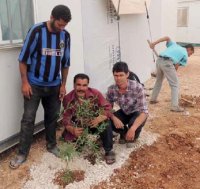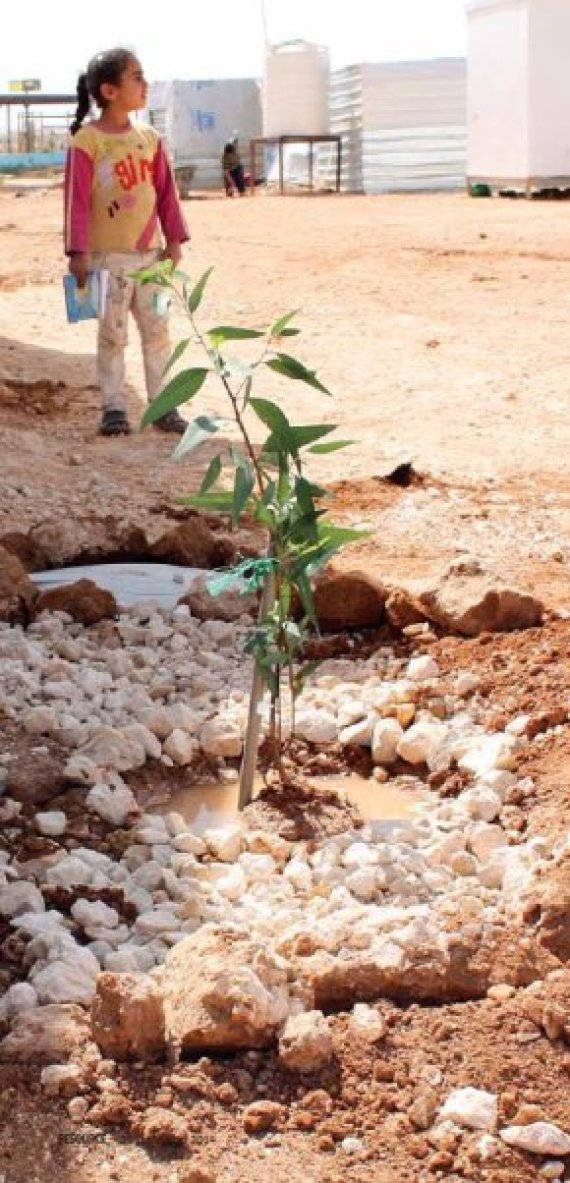Gardens for refugees
I still remember the impression the camp made on me when I first arrived there: endless rows of tents stretching to the horizon. They house more than 100,000 Syrian refugees in the Zaatari refugee camp in Jordan. Mainly families. Once I was inside I saw how the children played out of doors, in the sand. But the smell is unbearable. There are no sewers. All the human excrement gets mixed with the waste water and runs right through the streets. A doctor told me that 300 children are brought into the medical centre every day. In short, the problem was clear. The question was could I do anything about it?
Grid
The topic of my MSc research came up quite by chance, really. Minister Ploumen had noticed serious housing problems during his visit to Zaatari, and he asked the mayor of Amsterdam, Van der Laan, to send a team of urban developers to help. Because I was doing an internship at the time with a landscape architect in Amsterdam, I met someone who was involved in that project. On thing led to another and I ended up doing my final research project in Jordan.
The Zaatari camp is close to the border with Syria and is under the management of the UNHCR, the United Nations High Commission for Refugees. Most of the refugees are opponents of Assad who have fled a nearby town because of the bombardments. Although in some ways the camp looks like a village, a sense of threat is never very far away: the Jordanian army has placed a cordon of tanks around the perimeter to prevent the refugees from penetrating further into the country. this makes the camp practically a prison.
My workplace was initially on the compound of the UNHCR, a heavily fortified zone for the camp management and the aid workers. The camp management gave me permission to work with a few dozen refugees. I opted to run workshops based on the concept known as the Green Town Workshop developed by my supervisor Ingrid Duchart. Workshops give you the chance to find out what residents want and what they are capable of. Even the 25 September 2014 approach itself is unusual, since the UN uses strict guidelines for refugee camps, which state exactly how things should be done – very top down. As an example: Per refugee per day, 2100 calories of food and 35 litres of water should be available. Facilities are in proportion to the number of residents. The more residents, the more facilities. This kind of ‘grid model’ works fine when you have to set up a temporary refugee camp at great speed. The problem is that these kinds of camps are rarely temporary. On average, refugees stay in them for 17 years. So those being born in Zaatari now stand a good chance of growing up there. Over such a period, a camp often develops in an uncontrolled way. Family members move in together, trade and crafts get established, and so on. If you don’t address that, within a few years the camp has all the features of a slum. So it is better to try to steer the developments, not by imposing plans from above but by looking into what the residents want and need.
Refugee camp Zaatari
Black water
To find out what the refugees themselves wanted, I got them working with photoshop. Unconventional, perhaps, but it worked fine. I got the refugees to use the programme to edit an image of the camp to make it how they would like it. Of course that generated a lot of different images, but they all had a couple of key things in common: away with the open sewer, and more vegetation. But how do you organize that? The solution would have to be cheap and easy. That brought me to the idea of grey water gardens. These are based on the idea of separating waste water (grey water) from human excrement (black water). You drain the black water into a septic tank, and the grey water can be stored in the soil and used for growing plants and trees.
This is not as easy as it sounds. First of all, you have to dig a hole in the rocky soil next to the tent or barrack, and then you need to create a cultivable soil structure. Then you still need the right sort of vegetation, which is resilient to a desert climate, and an overflow for in case it does rain heavily once in a while. Trials showed that the idea was feasible. And residents responded with enthusiasm too. Not only because their sewerage problem was largely solved, but also because the vegetation improved their quality of life. Although they cannot grow any food crops using the grey water, just the sight of plants and trees in the camp was a great relief for them. Don’t forget that 90 percent of them were farmers before this. Growing a crop, even if it’s just one plant, fits their cultural identity.
Gruesome photo’s
But finding a solution doesn’t mean you are there. You still have to get it implemented. And that’s when the diplomatic fun starts. I started with field trials in a part of the camp where the waste water was a problem. Several tents there let the water run into one shared open sewer, with terrible consequences: a child drowned in it recently.

Creating gardens
We made a plan in collaboration with the residents. But part of the plan was that they would share the costs, paying the equivalent of about 200 euros. That turned out to be too much for the men I was negotiating with. They complained about it and would not budge. Of course I was terribly disappointed, until the next day when they reluctantly approached me and said they agreed. It turned out that their wives had been listening in, and had had serious talks with their husbands that evening. Didn’t they care about the safety of their children? That did the trick. And the project advanced, sometimes with big steps, sometimes with small ones. The NGOs were not entirely convinced at first. They were afraid the resident would use precious drinking water for the plants. But nothing like that happened in the trials, so I won them over to my side. I was able to take a key step thanks to the advice of UN environmental advisor Tom Corcoran, who was something of a mentor to me. He taught me a lot about the informal hierarchy within the camp community. Tom sent me to one of the big shots, the self-appointed minister of electricity. I spent a couple of days with his family, helping him start a grey water garden and explaining the idea behind it.
In retrospect, that was a crucial step. Once he threw his weight behind the project, things moved fast. Looking back, this was a strange situation. I got on well with the man but at the same time I could see that he was recruiting young men to fight with the rebels. Things like that constantly remind you that you are working in a conflict region. Many of the young men I talked to had fought with the Free Syrian Army. Almost all of them have a mobile phone with them with photos from the front. Sometimes gruesome photos. Others proudly showed me their wounds. I talked to one who had four bullet wounds. Some of these men don’t stay long – they only come to recover from their wounds, and then they go back to the war zone. I stayed in the Jordanian capital, Amman, two hours’ drive from the camp. I travelled up and down by bus every day. Sometimes I stayed the night in the heavily fortified compound. At night you sometimes heard faraway explosions from the bombardments over the border. That sound goes right through you.
Untold value
But it is terrific when your efforts eventually meet with more success than you had dared to hope for. Not only has the project partially got rid of the smell and the public health problem caused by the open sewers, but the plants and trees also have a clear effect on the wellbeing of the refugees.
The UN has responded to the project very positively. There are concrete plans for expanding it across the whole camp, so Zaatari may soon be graced with tens of thousands of gardens. The applied method was an eyeopener for the UN. It shows how small-scale initiatives can solve serious problems in the camp.
You know, you don’t immediately associate landscape architecture with aid in war zones. I didn’t either. The fact is that 90 percent of landscape designers work for the richest 10 percent of the human race. But through my research I have seen a whole new side to the value of my profession. The job’s been done in the Netherlands, as far as landscape makers are concerned, but in dry problem areas trees and plants are of untold value. Both ecologically and aesthetically. I think there is vast undiscovered territory for our field in problem regions and developing countries.’
Photo’s: Robert Kruijt


